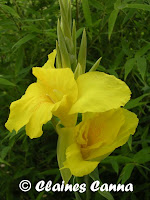Garden and forest. / Volume 7, Issue 339. [August 22, 1894, 331-340]
Cannas. NOTING the improvements in Cannas several years ago, a friend of mine gave it as his opinion that we should soon have varieties with flowers as large as those of the Gladiolus. That stage was past when Madame Crozy was introduced, some three years ago. This variety has been the standard by which all subsequent varieties of its color have been judged. When looking at a large bed containing some three hundred plants of Madame Crozy recently at the University garden, Cambridge, it was hard to imagine how this can be excelled. The dwarf, erect, free.-flowering habit of this variety, with its large spikes of scarlet flowers, bring it close to absolute perfection.
Going to Claredon Hills, Boston, the home of Mr. James Farquhar, I was astonished to see some of Crozy's latest productions, which, by special favor, Mr. Farquhar was allowed to select while in France last summer, some of which exceed even Madame Crozy in brilliancy of tone and finish. Most meritorious among these are:
Baron M. D. Hirsch: Flowers large, but brighter than the type, with a very narrow, but clearly defined, yellow edge.
Paola Radaelli: Deep crimson flowers and bright yellow edge.
 Antoine Crozy: More erect flowers.
Antoine Crozy: More erect flowers.
C. H. Morlin: Large, compact, vermilion spike and handsome foliage, which give it great promise both as a bedder and a pot-plant.
James Farquhar: Flowers striped as well as bordered with yellow.
Van dem Berg: With considerably larger flowers than the type, and of a lighter shade of scarlet, and a wide yellow margin. It is a strong dwarf grower.
Among some of the Crozy seedlings raised at Claredon Hills is one very bright and beautiful variety well adapted for bedding. It is dwarf, and though the flowers are small, the spikes are large and even, and last for a long time-a very good recommendation. It has never been named, and Mr. Macdonald, the foreman, said it had not been kept because it was thought to be any better than Crozy, but because it was different, and just as effective as a bedder.
Among yellow varieties of recent introduction it is hard to say which is at the head. Captain Suzzoni has large roundpetaled flowers, spotted with reddish brown, but does not carry either so large or handsome a spike as Florence Vaughan, the flowers of which are more densely and darkly spotted. Following this is Mrs. Cowing, raised by A. H. Fewkes, of Newton Highlands, Massachusetts, and recently decorated with a silver medal by the Massachusetts Horticultural Society. This carries an elegant spike of carmine spotted flowers, each standing out well and evenly, and giving a certain fullness of aspect often lacking in others.
Monsieur Crozy's introductions for 1895 will include the grand yellow Madame Montifiore, which is a very strong grower. The spikes are large, erect and open. In general form and color it resembles Captain Suzzoni. and may be described as a great improvement on that variety. I could not help observing how well Admiral Courbet, a fine canary-yellow bedder introduced several years ago, holds its own among the newer introductions.
While visiting among the growers I found every one in love with J. D. Cabos, the comparatively new bronze-leaved variety with salmon flowers. Admiral Aurellan, one of Crozy's for 1895, is several points ahead of this. The flowers, on comparison, are larger and more regular in outline. Ingegnoile Fratelli is another handsome dark-leaved variety with buff-colored flowers. General de Miribel is salmon, with green foliage, and Secretary Nicholas clear brick-red. Charles Henderson, so far as seen, has not come up to general expectation. The spike is open, regular and erect, and the flowers, though not extra large, are a very bright crimson. The general opinion is that it does not come up to Alphonse Bouvier. What was once considered a defect in this is now considered a recommendation by many. The hanging spike, when half open is succeeded by a secondary one just above it, and considerably enhancing its effective value. As far as I have seen, there is nothing new in the way of Paul Marquant. Its dwarf, erect habit and full spikes of satiny, salmon-red flowers should recommend it to all, and especially for winter blooming. Paul Bruant has extra-large vermilion-colored flowers, but they do not hold well, so that there are never many open at one time. Egandale is promising, and apparently is better as a foliage plant than President Carnot. To the many admirers of this lovely variety it will appear to be saying a good deal.

François Crozy is a new green-leaved, salmon-tinted variety, of which much was expected. It does not seem to hold its color well. As the first flowers to open were very fine in tone, I should like to hear from growers whether this color defect is likely to be characteristic.
Speaking about raising Cannas from seed, Mr. Macdonald showed me a lot of self-sown seedlings scattered where the bed had been last year, and particularly where a bunch of fifty or so came up together on a spot where he had dropped a handful of seed the previous autumn. From this one may conclude that Canna seeds sown in a cold frame in the autumn will come up the following spring.
Wellesley, Mass. T. D. Hatfeld.



































